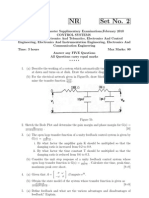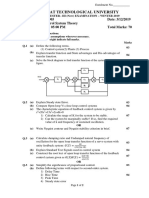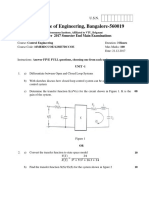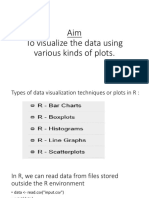0 ratings0% found this document useful (0 votes)
32 viewsGujarat Technological University
Gujarat Technological University
Uploaded by
Shivam PanchalThis document contains instructions and questions for an examination on instrumentation and process control. It includes 5 questions with 2 parts each, covering topics like:
1) Solving a differential equation using Laplace transform and explaining the importance of transfer functions.
2) Deriving transfer functions for processes like transportation lag and non-interacting systems.
3) Analyzing the response of a second order control system and discussing PID controllers.
4) Determining stability using Routh criterion and drawing a root locus diagram for a control system.
5) Explaining the construction and characteristics of instruments like bimetallic thermometers and pressure gauges.
Copyright:
© All Rights Reserved
Available Formats
Download as PDF, TXT or read online from Scribd
Gujarat Technological University
Gujarat Technological University
Uploaded by
Shivam Panchal0 ratings0% found this document useful (0 votes)
32 views2 pagesThis document contains instructions and questions for an examination on instrumentation and process control. It includes 5 questions with 2 parts each, covering topics like:
1) Solving a differential equation using Laplace transform and explaining the importance of transfer functions.
2) Deriving transfer functions for processes like transportation lag and non-interacting systems.
3) Analyzing the response of a second order control system and discussing PID controllers.
4) Determining stability using Routh criterion and drawing a root locus diagram for a control system.
5) Explaining the construction and characteristics of instruments like bimetallic thermometers and pressure gauges.
Original Description:
Original Title
151605-2150504-IPC
Copyright
© © All Rights Reserved
Available Formats
PDF, TXT or read online from Scribd
Share this document
Did you find this document useful?
Is this content inappropriate?
This document contains instructions and questions for an examination on instrumentation and process control. It includes 5 questions with 2 parts each, covering topics like:
1) Solving a differential equation using Laplace transform and explaining the importance of transfer functions.
2) Deriving transfer functions for processes like transportation lag and non-interacting systems.
3) Analyzing the response of a second order control system and discussing PID controllers.
4) Determining stability using Routh criterion and drawing a root locus diagram for a control system.
5) Explaining the construction and characteristics of instruments like bimetallic thermometers and pressure gauges.
Copyright:
© All Rights Reserved
Available Formats
Download as PDF, TXT or read online from Scribd
Download as pdf or txt
0 ratings0% found this document useful (0 votes)
32 views2 pagesGujarat Technological University
Gujarat Technological University
Uploaded by
Shivam PanchalThis document contains instructions and questions for an examination on instrumentation and process control. It includes 5 questions with 2 parts each, covering topics like:
1) Solving a differential equation using Laplace transform and explaining the importance of transfer functions.
2) Deriving transfer functions for processes like transportation lag and non-interacting systems.
3) Analyzing the response of a second order control system and discussing PID controllers.
4) Determining stability using Routh criterion and drawing a root locus diagram for a control system.
5) Explaining the construction and characteristics of instruments like bimetallic thermometers and pressure gauges.
Copyright:
© All Rights Reserved
Available Formats
Download as PDF, TXT or read online from Scribd
Download as pdf or txt
You are on page 1of 2
Seat No.: ________ Enrolment No.
___________
GUJARAT TECHNOLOGICAL UNIVERSITY
BE - SEMESTER–V (NEW) - EXAMINATION – SUMMER 2016
Subject Code:2150504 Date:11/05/2016
Subject Name:Insrumentation & Process Control
Time:02:30 PM to 05:00 PM Total Marks: 70
Instructions:
1. Attempt all questions.
2. Make suitable assumptions wherever necessary.
3. Figures to the right indicate full marks.
Q.1 (a) Solve the following differential equation by Laplace transform. 07
𝑑2 𝑥 𝑑𝑥
+ 2 + 2𝑥 = 2
𝑑𝑡 2 𝑑𝑡
′ (0)
𝑥(0) = 𝑥 =0
(b) With neat sketch explain the importance of transfer function 07
Q.2 (a) What is Transportation lag? Derive the transfer function of transportation lag. 07
Find Amplitude ratio and phase angle for the same.
(b) A thermometer exhibiting first order dynamics having time constant of 5 sec is 07
at steady state temperature of 25oC. At time t=0, the thermometer is inserted in
a bath at 750c. Show that the value of response reaches 63.2% of ultimate value
of response when time elapsed is equal to one time constant.
OR
(b) Derive the transfer function of non-interacting system. 07
Q.3 (a) The transfer function of the second order control system is given as, 07
16
𝐺(𝑠) = 2
1.5𝑠 + 2.4𝑠 + 6
A step change of magnitude 6 is given in the input variable. Determine,
1) Overshoot 2) Rise time 3) Period of oscillation
4) Maximum value of response 5) Ultimate Value of response
(b) Discuss the transfer function for P, PI and PID controller 07
OR
Q.3 (a) Determine the overall transfer function C(s)/R(s) for the system shown 07
in the following figure.
(b) Explain Servo and Regulator mechanism problem 07
Q.4 (a) Determine the stability if the given control system by Routh Criterion 07
𝐾𝑐
𝐺(𝑠) =
𝑠(𝑠 = 1)(𝑠 + 2)
(b) A proportional derivative controller having the gain Kc and the derivative time 07
is 4 is used to controller two first order non-interacting systems having time
constant τ1=1 and τ2=0.5. If the gain of the process is 0.5. Sketch the Root locus
diagram for the control system. The transfer function of the measuring element
is 1/S.
OR
Q.4 (a) Derive the offset for first order system controlled by proportional controller and 07
unit step change is given to the set point.
(b) Sketch the asymptotic Bode diagram for the following control system 07
𝐾𝑐
𝐺(𝑠) =
(10𝑠 + 1)(0.5𝑠 + 1)
Q.5 (a) Starting with the principal and working, explain the construction of Bimetallic 07
thermometer with neat sketch.
(b) Discuss different static and dynamic characteristics of an instrument. 07
OR
Q.5 (a) Describe variable area meter with neat figure. Also explain the methodology for 07
determination of flow rate with equation.
(b) Enlist different pressure measuring instrument. Explain in detail Bellows 07
pressure gauge for the pressure measurement.
*************
You might also like
- Groups Graphs and Trees An Introduction To The Geometry of Infinite GroupsDocument245 pagesGroups Graphs and Trees An Introduction To The Geometry of Infinite Groupsabdulbaset Awad100% (1)
- Manifesting Abundance Srdjan RojeDocument20 pagesManifesting Abundance Srdjan RojeTanana97No ratings yet
- A Scenario Based Questions and SolutionsDocument8 pagesA Scenario Based Questions and SolutionsRajesh Hagalwadi100% (1)
- Gujarat Technological UniversityDocument2 pagesGujarat Technological UniversityShivam PanchalNo ratings yet
- Gujarat Technological UniversityDocument2 pagesGujarat Technological UniversityJay PATELNo ratings yet
- Old Question Paper Control SystemsDocument7 pagesOld Question Paper Control SystemsSatendra KushwahaNo ratings yet
- Gujarat Technological UniversityDocument2 pagesGujarat Technological UniversityHerat HirparaNo ratings yet
- IPC PaperDocument2 pagesIPC PaperBhavik YoganandiNo ratings yet
- Gujarat Technological UniversityDocument2 pagesGujarat Technological UniversityNallaNo ratings yet
- Gujarat Technological UniversityDocument2 pagesGujarat Technological UniversityKundan BhagatNo ratings yet
- Control Theory Summer 2013 CTDocument2 pagesControl Theory Summer 2013 CTvisupinuNo ratings yet
- IPC Paper 2Document2 pagesIPC Paper 2Bhavik YoganandiNo ratings yet
- 141312-141701-Control - Winter - 2013 CT PDFDocument2 pages141312-141701-Control - Winter - 2013 CT PDFvisupinuNo ratings yet
- Question Paper of PDCDocument2 pagesQuestion Paper of PDCtapasdoraNo ratings yet
- Gujarat Technological UniversityDocument2 pagesGujarat Technological Universityfeyayel988No ratings yet
- Gujarat Technological UniversityDocument3 pagesGujarat Technological Universityfeyayel988No ratings yet
- Gujarat Technological UniversityDocument3 pagesGujarat Technological UniversityMandy745No ratings yet
- Gujarat Technological UniversityDocument2 pagesGujarat Technological UniversityShivam PanchalNo ratings yet
- PTEE7301 April-2021Document2 pagesPTEE7301 April-2021imman46920No ratings yet
- Gujarat Technological UniversityDocument2 pagesGujarat Technological UniversityShivam Panchal100% (1)
- Gujarat Technological UniversityDocument2 pagesGujarat Technological UniversityvisupinuNo ratings yet
- CT PyqsDocument12 pagesCT PyqsDhruvalNo ratings yet
- Cs Winter 21 GtuDocument3 pagesCs Winter 21 GtuSandeep kumarNo ratings yet
- CT Dec 2011Document3 pagesCT Dec 2011vpj100No ratings yet
- r05320803 - Process Dynamics & ControlDocument7 pagesr05320803 - Process Dynamics & ControlSRINIVASA RAO GANTANo ratings yet
- March 2022Document2 pagesMarch 2022Narmada BheemaNo ratings yet
- Model QP 21ch52Document4 pagesModel QP 21ch52RochakNo ratings yet
- Gujarat Technological University: Subject Code:2141004 Subject Name:Control System Engineering Time:10:30 AM To 01:00 PMDocument3 pagesGujarat Technological University: Subject Code:2141004 Subject Name:Control System Engineering Time:10:30 AM To 01:00 PMvisupinuNo ratings yet
- CSD W-2022Document2 pagesCSD W-2022Heet PatelNo ratings yet
- Gujarat Technological UniversityDocument2 pagesGujarat Technological UniversityHerat HirparaNo ratings yet
- Gujarat Technological UniversityDocument2 pagesGujarat Technological UniversityShivam PanchalNo ratings yet
- Gujarat Technological University: Subject Code: 171701 Date: Subject Name: Control System Design Time: Total Marks: 70Document2 pagesGujarat Technological University: Subject Code: 171701 Date: Subject Name: Control System Design Time: Total Marks: 70Ti TitNo ratings yet
- JNTU Old Question Papers 2007Document7 pagesJNTU Old Question Papers 2007Srinivasa Rao GNo ratings yet
- Summer 2022 Question PaperDocument4 pagesSummer 2022 Question Papershejwalpranjal6No ratings yet
- 22 23Document2 pages22 23Goura Sundar TripathyNo ratings yet
- Nr220405-Control SystemsDocument8 pagesNr220405-Control SystemsSRINIVASA RAO GANTANo ratings yet
- 3130905Document2 pages3130905manish_iitr0% (1)
- Control Theory 2010Document2 pagesControl Theory 2010Yashpal AvaiyaNo ratings yet
- BMS College of Engineering, Bangalore-560019: May 2016 Semester End Main ExaminationsDocument3 pagesBMS College of Engineering, Bangalore-560019: May 2016 Semester End Main Examinationskoushik bhatNo ratings yet
- Gujarat Technological UniversityDocument2 pagesGujarat Technological UniversityNallaNo ratings yet
- All Questions Are Compulsory. Make Suitable Assumptions Wherever NecessaryDocument2 pagesAll Questions Are Compulsory. Make Suitable Assumptions Wherever Necessaryf20212955No ratings yet
- Electrical Machines Controls. Ree409Document4 pagesElectrical Machines Controls. Ree409Arshad SaifiNo ratings yet
- Ece441 CaDocument2 pagesEce441 CaIfeoluwa DareNo ratings yet
- Stucor Qp-Ec3351Document15 pagesStucor Qp-Ec3351Naveen KumarNo ratings yet
- Gujarat Technological UniversityDocument2 pagesGujarat Technological UniversityJay PATELNo ratings yet
- 2015-2016 (L-4, T-1) - Che PDFDocument52 pages2015-2016 (L-4, T-1) - Che PDFMahmud Rahman BizoyNo ratings yet
- Csmodel 2Document4 pagesCsmodel 2Anonymous L7XrxpeI1zNo ratings yet
- 2015 2016 - L 4 - T 1 - CheDocument52 pages2015 2016 - L 4 - T 1 - CheBiplab SarkerNo ratings yet
- CE Model Question Paper 2019 - 16ME72Document3 pagesCE Model Question Paper 2019 - 16ME72ashitaNo ratings yet
- Gujarat Technological UniversityDocument2 pagesGujarat Technological UniversityTanvir KaziNo ratings yet
- Control Systems 2010-11 ComprehensiveDocument2 pagesControl Systems 2010-11 ComprehensiveArkadeep ChowdhuryNo ratings yet
- AE61Document4 pagesAE61Anima SenNo ratings yet
- 2018 Sem EndDocument2 pages2018 Sem EndahmadNo ratings yet
- Gujarat Technological UniversityDocument2 pagesGujarat Technological UniversityJay PATELNo ratings yet
- Gujarat Technological UniversityDocument2 pagesGujarat Technological UniversityMORESAGARNo ratings yet
- Ele 2223 LCT-1Document3 pagesEle 2223 LCT-1shreyashmagic99No ratings yet
- Tutorial 8Document2 pagesTutorial 8Gaurav ANo ratings yet
- QUESTION BANK of Control Systems Engineering PDFDocument12 pagesQUESTION BANK of Control Systems Engineering PDFMouhanit LimbachiyaNo ratings yet
- Cs April 2011Document8 pagesCs April 201129viswa12No ratings yet
- CST - W2022Document2 pagesCST - W2022Shivam PanchalNo ratings yet
- Log-Linear Models, Extensions, and ApplicationsFrom EverandLog-Linear Models, Extensions, and ApplicationsAleksandr AravkinNo ratings yet
- Student Solutions Manual to Accompany Economic Dynamics in Discrete Time, second editionFrom EverandStudent Solutions Manual to Accompany Economic Dynamics in Discrete Time, second editionRating: 4.5 out of 5 stars4.5/5 (2)
- SR No Surname Yuvak Name Father Name AGE: Stsangdiksha Granth Online Exam - Yadi (Dabhasa Mandal)Document2 pagesSR No Surname Yuvak Name Father Name AGE: Stsangdiksha Granth Online Exam - Yadi (Dabhasa Mandal)Shivam PanchalNo ratings yet
- 19-5010 NT Test-2 Answer SheetDocument10 pages19-5010 NT Test-2 Answer SheetShivam PanchalNo ratings yet
- Weekly Diary (Week - 1-8)Document16 pagesWeekly Diary (Week - 1-8)Shivam PanchalNo ratings yet
- Ree Fstin: KttomDocument1 pageRee Fstin: KttomShivam PanchalNo ratings yet
- CH-4 Plant Location & LayoutDocument10 pagesCH-4 Plant Location & LayoutShivam PanchalNo ratings yet
- Non-Interacting System (Step Input) : Government Engineering College, Valsad Chemical Engineering DepartmentDocument6 pagesNon-Interacting System (Step Input) : Government Engineering College, Valsad Chemical Engineering DepartmentShivam PanchalNo ratings yet
- Publish Analytics: 10 ResponsesDocument4 pagesPublish Analytics: 10 ResponsesShivam PanchalNo ratings yet
- Weekly Diary (Week - 1-8)Document16 pagesWeekly Diary (Week - 1-8)Shivam PanchalNo ratings yet
- First Order System Dynamics: Government Engineering College, Valsad Chemical Engineering DepartmentDocument8 pagesFirst Order System Dynamics: Government Engineering College, Valsad Chemical Engineering DepartmentShivam PanchalNo ratings yet
- Gujarat Technological University: Ntegrated Ersonality Evelopment OurseDocument4 pagesGujarat Technological University: Ntegrated Ersonality Evelopment OursejpbhimaniNo ratings yet
- Dabhasa Yuvak Results of Final Test - 1.11.20Document1 pageDabhasa Yuvak Results of Final Test - 1.11.20Shivam PanchalNo ratings yet
- Gujarat Technological University: W.E.F. AY 2018-19Document4 pagesGujarat Technological University: W.E.F. AY 2018-19Shivam PanchalNo ratings yet
- Gujarat Technological University: W.E.F. AY 2018-19Document3 pagesGujarat Technological University: W.E.F. AY 2018-19Shivam PanchalNo ratings yet
- Gujarat Technological UniversityDocument3 pagesGujarat Technological UniversityShivam PanchalNo ratings yet
- Gujarat Technological UniversityDocument2 pagesGujarat Technological UniversityShivam PanchalNo ratings yet
- Gujarat Technological UniversityDocument2 pagesGujarat Technological UniversityShivam PanchalNo ratings yet
- MTO-I Paper Nov 2018Document2 pagesMTO-I Paper Nov 2018Bhavik Yoganandi100% (1)
- Gujarat Technological UniversityDocument2 pagesGujarat Technological UniversityShivam PanchalNo ratings yet
- Gujarat Technological UniversityDocument2 pagesGujarat Technological UniversityShivam PanchalNo ratings yet
- Gujarat Technological UniversityDocument2 pagesGujarat Technological UniversityShivam PanchalNo ratings yet
- Gujarat Technological UniversityDocument2 pagesGujarat Technological UniversityShivam PanchalNo ratings yet
- Gujarat Technological UniversityDocument2 pagesGujarat Technological UniversityShivam PanchalNo ratings yet
- Gujarat Technological UniversityDocument2 pagesGujarat Technological UniversityShivam PanchalNo ratings yet
- Gujarat Technological UniversityDocument2 pagesGujarat Technological UniversityShivam PanchalNo ratings yet
- Gujarat Technological UniversityDocument1 pageGujarat Technological UniversityShivam PanchalNo ratings yet
- Gujarat Technological University Subject Name:Mechanical OperationDocument2 pagesGujarat Technological University Subject Name:Mechanical OperationShivam PanchalNo ratings yet
- Gujarat Technological UniversityDocument2 pagesGujarat Technological UniversityShivam Panchal100% (1)
- Lab 4 AiDocument6 pagesLab 4 AiAtif JalalNo ratings yet
- A 3D Model Based Control of An ExcavatorDocument7 pagesA 3D Model Based Control of An Excavatorminaya2008No ratings yet
- Mrsptu B.tech. (Me) 1st Year (Sem 1-2) Syllabus 2019 Batch Onwards Updated On 23.09.2019Document20 pagesMrsptu B.tech. (Me) 1st Year (Sem 1-2) Syllabus 2019 Batch Onwards Updated On 23.09.2019Prabhawati DeviNo ratings yet
- Chapter 4 Torsion PDFDocument30 pagesChapter 4 Torsion PDFadlinasir67% (3)
- Manegerial EconomicsDocument17 pagesManegerial EconomicsPrincess EscovidalNo ratings yet
- Thesis On Tall BuildingDocument64 pagesThesis On Tall BuildingDip_Azrin100% (4)
- 5 Session 18-19 (Z-Test and T-Test)Document28 pages5 Session 18-19 (Z-Test and T-Test)Shaira CogollodoNo ratings yet
- Youtube Multi Downloader Online Free PDFDocument5 pagesYoutube Multi Downloader Online Free PDFBikashGuptaNo ratings yet
- Chap 5Document24 pagesChap 5api-37022560% (1)
- Sit 212 Lecture NoteDocument99 pagesSit 212 Lecture NoteTracy JaneNo ratings yet
- (IJCST-V9I2P10) :DR - Shine N DasDocument6 pages(IJCST-V9I2P10) :DR - Shine N DasEighthSenseGroupNo ratings yet
- A Student's Manual For A First Course in General Relativity: Robert B. ScottDocument10 pagesA Student's Manual For A First Course in General Relativity: Robert B. Scottmehrdad022No ratings yet
- Dynamics of Machinery Oral Question BankDocument22 pagesDynamics of Machinery Oral Question BankSurajKahateRajputNo ratings yet
- Catalogo ReductorDocument106 pagesCatalogo ReductorOmar ArdilaNo ratings yet
- Phase-Lag Compensation Using Frequency Response: Active Learning Assignment OnDocument18 pagesPhase-Lag Compensation Using Frequency Response: Active Learning Assignment OnHardik PatoliyaNo ratings yet
- Number Theory KSOU TextbookDocument190 pagesNumber Theory KSOU Textbookindujois021118No ratings yet
- Chapter - 24 Ray Optics and Optical InstrumentsDocument37 pagesChapter - 24 Ray Optics and Optical Instrumentsagoel0844No ratings yet
- Center of MassDocument6 pagesCenter of MassDavid AponteNo ratings yet
- Mid Term 2022-2023 Paper 1Document6 pagesMid Term 2022-2023 Paper 1Nisa SajidNo ratings yet
- Chapter 7 - Stresses in Beams - Part 1 - Mark Ups LectureDocument58 pagesChapter 7 - Stresses in Beams - Part 1 - Mark Ups LecturelarraNo ratings yet
- Unit V Fourier Transform PDFDocument53 pagesUnit V Fourier Transform PDFRahul JRNo ratings yet
- Calculation of Marine PropellersDocument14 pagesCalculation of Marine PropellersMahdiNo ratings yet
- Experiment 3Document43 pagesExperiment 3PUSHPITHANo ratings yet
- Pointers: Starting Out With C++, 3 EditionDocument39 pagesPointers: Starting Out With C++, 3 EditionswapnilNo ratings yet
- CUHK MATH 3060 Lecture Notes by KS ChouDocument98 pagesCUHK MATH 3060 Lecture Notes by KS ChouAlice YuenNo ratings yet
- Gw-Instek C - 01-20Document10 pagesGw-Instek C - 01-20Jose M PeresNo ratings yet
- Units in ROMDocument10 pagesUnits in ROMMehmetcan TutarNo ratings yet



















































































































